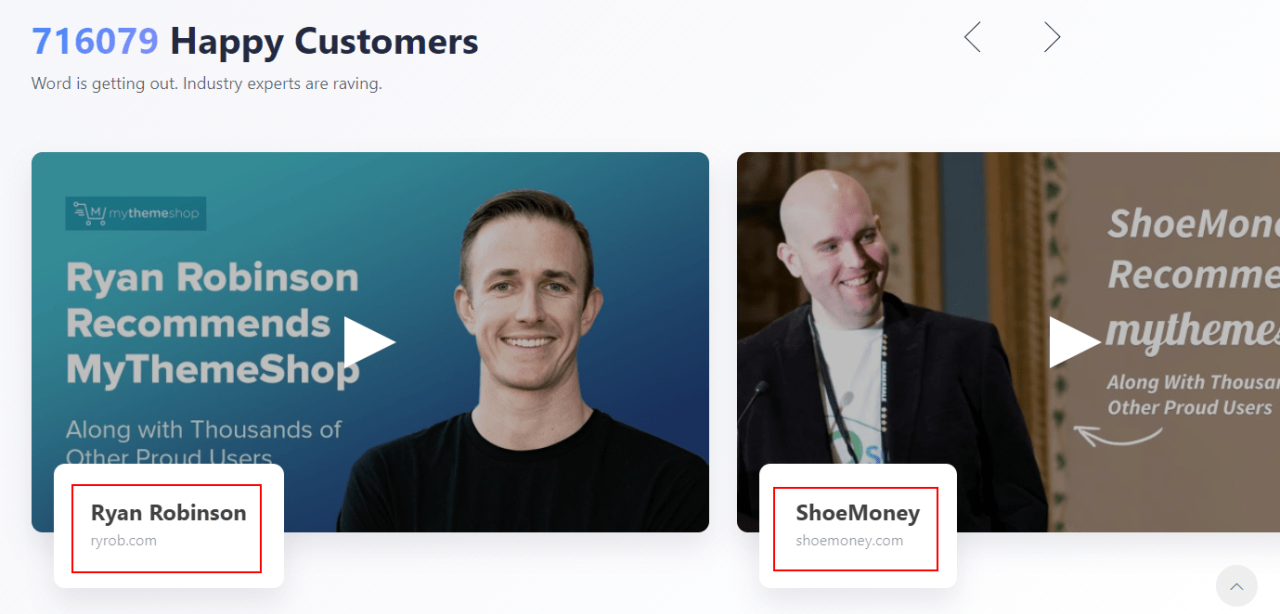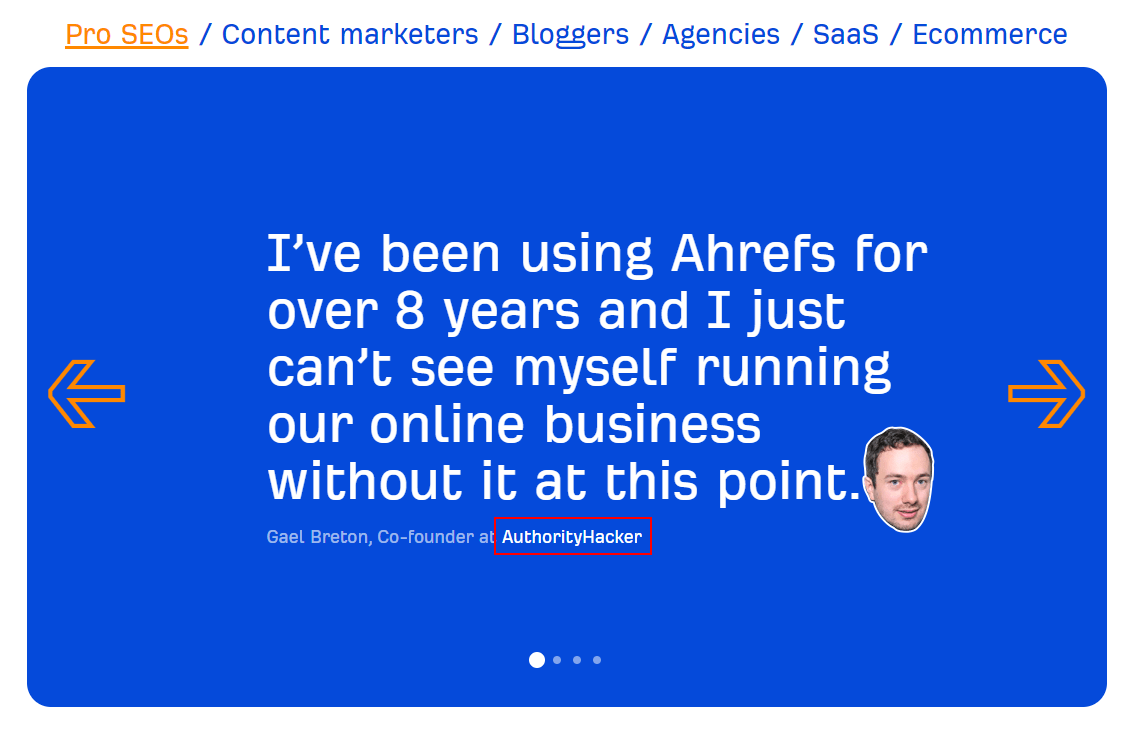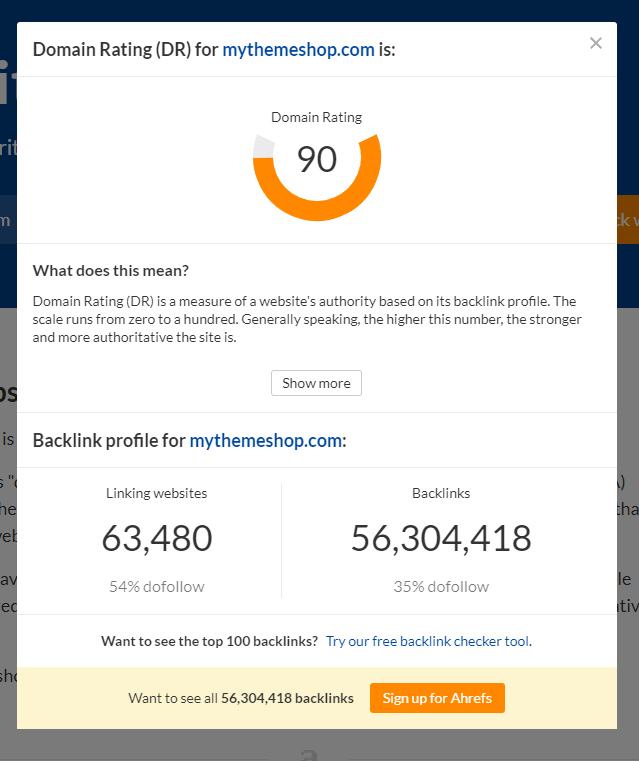As SEOs, we owe it to ourselves to try every link building tactic available to us. So here’s something you might not have heard of — testimonial link building.
The great thing about this strategy is that you don’t need to rely on special tools or apps to make it work. Honestly, this is a link building strategy that you can roll out any day of the week.
Sounds interesting, right?
The testimonial link building technique is one of the best ways to get high-quality backlinks, homepage links in most cases. And in this post, we’ll tell you everything you need to know about this strategy.
What Is Testimonial Link Building?
The testimonial link building method is exactly as it sounds. You get third-party websites to link back to your website in exchange for testimonials of their product or service.
More specifically, you provide companies with positive reviews about their products that they can display on their landing pages to impress their potential customers. In exchange, they’ll link back to your site. It’s a win-win scenario for everyone involved.
That’s it. That’s the concept behind testimonial link building.
Can Anyone Use Testimonial Link Building?
Yes, anyone can use testimonial link building technique to get high quality backlinks.
The real question is whether you should use it or not.
You see, this link building strategy will only work for you if you have products to review. And ideally, you want to review products related to your niche.
If you’re an affiliate marketer, then there’s a good chance that you’ve already reviewed products before — which is great. That means you’ll have some thoughts on a product that’s worth sharing.
But if you don’t, then you’ll need to search for products that you can review. We’ll explain later on how you can find products to review for your testimonial link building campaign. But if you’re not willing to do the work or if you’d rather focus on other link building strategies, then this one might not be for you.
Testimonial Link Building Examples
A testimonial will most likely appear on the homepage of a website. Depending on the format, it could either be in written format or presented through a video recording.
It should be noted that not all brands include backlinks. So it’s important that you only work with those that do. Otherwise, you’ll be wasting your time and resources.
And even if the brands you found are open to adding backlinks, you have to make sure that these are do-follow links. If the links they give out are no-follow links, you won’t get the SEO benefits associated with high-quality backlinks which makes the whole thing kind of pointless.
The Benefits of Testimonial Link Building
There’s are good reasons why online marketers and link building experts like testimonial links.
You Don’t Need to Write Long-Form Content
Unlike a guest post strategy, you won’t need to write long articles in order to build links. You’ll only need to write a paragraph at most to get a testimonial link.
And in some cases, you won’t have to write anything at all. You can just record your video testimonial and then send them to the brand you’re working with.
You Are Less Likely to Get Rejected
Your testimonial link building efforts will have a high success rate as compared to other strategies.
With broken link building, for example, you’ll have to explain to businesses the consequences of having broken links. And if you fail to make them understand, they’ll be less receptive to replacing their broken links with yours.
Blogger outreach strategies can also be difficult since not all businesses have a need for content, especially those that have an in-house team of writers.
But all brands understand the importance of having testimonials on their site. In fact, they’re actively looking for influential customers that are open to submitting testimonials. That’s why you’re less likely to get rejected.
You Get Some Credibility
The perks of this strategy go beyond backlinks. People have the impression that those who get featured on testimonials are experts in their fields. And in most cases, they are right.
So if you’re getting featured all the time by different brands, that must help you build some authority for your business.
You Will Rank Higher on Search Engines
Successful marketing experts know the value of receiving powerful homepage links. If owners of authoritative sites link back to you, it’s almost certain that you’ll rank higher on Google and other search engines.
You Will Get Some Exposure
Getting your blurb featured prominently on other sites will bring some attention to your business. A potential buyer might come across your testimonial and click on your link to check you out. That’s a great deal considering all you did was write an awesome review.
How to Get Testimonial Links
Testimonial link building doesn’t require technical know-how. That’s what makes it an ideal strategy for those with little to no knowledge about link building.
What do you need to get started?
For the most part, all you’ll need is a spreadsheet and the guts to send out emails to people who don’t know you personally.
A tool that’ll help you find a lead’s email address might help but is not necessary. We’ll explain this in more detail in a later section.
Here’s how you can get high-quality links (and potential customers) from large- and micro-business websites:
Step 1: Find Products and Services to Review
If you already have products that you can review, then you can start with those. Otherwise, you’ll need to find products and services to review and write testimonials about.
We should point out that these don’t have to be physical products. You could focus on digital goods and services if that’s a better match for your niche.
It’s also important that you’ll need to be an actual user of the products being reviewed. Not only is it morally wrong to write reviews about a product you’ve not even tried, but there might also be legal ramifications to this. So better be on the safe side.
Besides, some companies can check if you really are a customer of theirs or if you’re just looking to get featured on their site.
Remember that your reputation is also on the line here. You don’t want to mislead a potential buyer.
Having a SEO spreadsheet would help you keep track of all your options.
Tip: Some companies let people try their products and services for free. While free trials don’t last forever, they will give you enough time to try all of its features and see if they are worth recommending or not. However, this strategy will only result in a testimonial backlink if you are a really well-known influencer in the industry.
Who Should You Target?
As suggested earlier, you should only work with brands that fall within your niche. Having a list that’s too broad will only hurt your campaign in the long run.
It’s just as important to find businesses that display testimonials on their websites and allow backlinks. Your target list should only include legitimate companies. If you work with shady sites, you could find yourself on the receiving end of harsh criticism from upset customers.
Most of all, you should only write testimonials for products that you truly enjoy using. It’s hard to write good things about a product or service that does not meet your standards.
How to Find the Right Target
There are different approaches you could take to find the right businesses to target. One of the simplest ways is to search Google for products that are relevant to your industry.
If you’re in the graphic design space, you can do a Google search for products and services related to that niche. For example, a search for “best tools for graphic designers” will bring up a whole lot of options.
You might also find some options when you search for “graphic design resources”.
It’s also possible to find inspiration from your competitors. Go to their sites and see what products and services they recommend. You can then check to see if those businesses are displaying testimonials with links on their homepage
Another way to find link targets is by carefully analyzing your industry. Think of all the possible products or services that a user in that space might need. And after you have some data, search for businesses that provide solutions in that category.
How to Check a Website’s Authority
You’ll want to prioritize working with authoritative sites. But how will you know which ones fall under that category?
Relax. It’s not that hard to do.
There are online resources that you can use to see how authoritative a site is. And the best part? You can use some of these tools for free. Ahrefs’ Website Authority Checker is one such example.
Moz also has its own version called Free Domain SEO Analysis Tool.
You want to have a list of websites that have a high domain rating. The higher the domain rating, the better.
Step 2: Look for Business Contact Details
Once you have a list of businesses that you want to work with, you can now start collecting their contact information. You need to find out who it is you need to talk to and get their email addresses.
Some businesses will have a dedicated page filled with contact details or a contact form you can fill out. These are worth trying. However, there are tools that you can use to find the contact details of specific people within the company.
Email lookup tools allow your to find the names and email addresses of company employees by entering the website. Popular options include Find That Email, FindThatLead, and Email Finder by Hunter.io.
Admittedly, these services can be expensive — especially for first-time marketers. So it’s hard to recommend using the paid versions if you’re just starting out. However, these tools have free versions as well. There is a limit on how many emails you can get per day but it should be enough to get you started.
If you can’t find a person’s email using a lookup service, you can try social media. For example, you can search for the company on LinkedIn and see the names of the employees working there. Find the right persons to contact. If you’re lucky, they might have their contact details displayed on their profiles.
Tip: As tempting as it might be, you shouldn’t contact employees through social media if you can avoid it. Not only does it make you look unprofessional, but you also risk irritating them to the point that they won’t want to work with you. Think about it: Would you want marketers contacting you on your personal social media account? Probably not, right?
After you’re done, go over your list of businesses and tighten it. Your list should only include websites that have high authority and accurate contact information.
Step 3: Send Your Pitch
You don’t want to send your review right away. What you want to do instead is send a pitch. Explain to the recipient what it is you want to do and how it can help them.
Keep your pitch short. Be direct to the point. And make sure you personalize your pitch. Don’t send the same generic email to everyone. You can use a template but you’ll have to edit certain details to cater to the business you’re writing to.
You’ll also need to confirm what type of testimonial they’ll need from you. Do they want a short blurb? If so, how long or short does it have to be? Or maybe they want you to send a video. If that’s the case, what file format will they accept?
You should only work on the testimonial itself after you’ve received confirmation from the company. That way, you know you’re not wasting each other’s time.
Here’s a sample email pitch that you can modify as you see fit:
Hi [Recipient’s Name],
My name is [Your Name] and I’m the owner of a website called [Your Website].
I’ve used your [Name of Product or Service] and I have to say — I was impressed. I especially like how [Name of Feature] helped me [Achievement].
I loved [Name of Product or Service] so much that I’ll be more than happy to write a testimonial that you can use on your website and as part of your marketing materials.
Are you interested in receiving a testimonial from a very satisfied customer?
If you are interested, let me know how you’d like to proceed.
Thanks!
[Your Name]
It’s important that you don’t sound aggressive. That way, you’re more likely to receive a reply.
Step 4: Write Your Testimonial
After getting the green light, you can start writing or shooting your video testimonial.
The biggest challenge when writing a testimonial is making it sound relatable to potential buyers of the product. Unlike SEO agencies, you don’t have an army of writers to help you out. So you better familiarize yourself with the best practices for writing testimonials.
Here are a couple of tips on writing a killer testimonial:
- Identify a Problem — What problem is the product or service trying to solve? Tell the reader what problem made you try the product. And make sure that it’s a problem they’ll be able to relate to.
- Mention Key Features — After defining the problem, tell the reader what product features helped address those problems.
- Share the Results — Let everyone know how the product was able to help you achieve your goal. If you tried SEO software, did it help you get more traffic? Did you rank higher on search engines? Did it generate more sales? Tell people how the product improved your life or business.
You’ll also find some testimonials where the reviewer had doubts about the product at first but was proven wrong in the end. If you’ve felt the same way, you can try writing a testimonial that way. It makes a testimonial sound more believable. And it makes you sound more human too.
Since written testimonials are often short, you’ll need to be as concise as possible. That means learning how to deliver a ton of information in as few words as you comfortably can. You have a bit more leeway if you’re doing videos.
You should also start thinking like a potential buyer. What words will you need to see to convince you to buy the product?
But whatever you do, don’t exaggerate. Give an honest assessment of the product.
If everything goes according to plan, the product owner should publish your testimonial with a link pointing to your site.
Now all you have to do is rinse and repeat.
Conclusion
Knowing what you know now, you should have a better understanding of why so many marketers prefer testimonial link building over other link building methods. It’s a pretty straightforward method with a high success rate.
With good research, a solid pitch email and a well-crafted testimonial, you can implement testimonial link building as part of your SEO strategy and get great results.
You can even use this technique to build relationships with the brands you reviewed. For example, you could work with them again in the future to review their new products.






